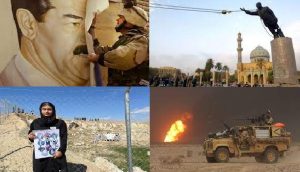21-03-2023
WASHINGTON/ LONDON/ BAGHDAD: The invasion of March 2003 was a catastrophe for Iraq and its people.
More proof of that, measured in broken lives, was at a suspected site of a mass grave in the desert outside Sinjar, not far from the border with Syria.
 Survivors of one of Iraq’s damaged communities, the Yazidis, looked on as the earth in a marble quarry was excavated. On a wire fence around the site were photos of dozens of people, mostly men, who had been killed by jihadists from the Islamic State group. They were from Zile-li, a village near the quarry, where 1,800 men were taken and killed on 3 August 2014.
Survivors of one of Iraq’s damaged communities, the Yazidis, looked on as the earth in a marble quarry was excavated. On a wire fence around the site were photos of dozens of people, mostly men, who had been killed by jihadists from the Islamic State group. They were from Zile-li, a village near the quarry, where 1,800 men were taken and killed on 3 August 2014.
The Yazidis revere both the Quran and the Bible; their religion is influenced by both Christianity and Islam. Islamic State considered them to be infidels and carried out a genocidal assault. It happened after the Americans and British had ended their occupation, but a direct line links the massacre to the invasion, and the disastrous years that followed.
Among those watching the excavation was Naif Jasso, the Sheikh of Kocho, a Yazidi community that suffered an even worse attack than Zile-li. He said that in Kocho, 517 people out of a population of 1,250 were killed by jihadists from IS, also known as ISIS or Daesh.
In Zile-li, men were separated from their families at gunpoint and shot dead at the quarry. Sofian Saleh, who was 16 at the time, was among the crowd at the excavation. He is one of only two men from Zile-li who survived. As he  waited for death with his father, brother and 20 to 30 other men, he saw another group shot dead. Their bodies tumbled down a cliff into the quarry. Then it was their turn.
waited for death with his father, brother and 20 to 30 other men, he saw another group shot dead. Their bodies tumbled down a cliff into the quarry. Then it was their turn.
“They tied our hands from behind before the shooting. They took us and threw us on the ground,” he said.
Sofian’s father and brother were killed, but he survived because bodies fell on him, covering him up.
Islamic State was using its favorite tactic. First, they killed the men, then took the women as slaves. Children were removed from their mothers to be indoctrinated as IS recruits. A mother sitting near the suspected grave wept as she remembered the baby ripped from her and given to a jihadist family.
Next to the wire fence around the site, Suad Daoud Chatto, a woman in her 20s, stood with a poster. On it were the faces of nine men from her extended family who were killed, and two missing female relatives? She said jihadists captured her in 2014 when she was 16, along with many other women and girls, and held her in Syria. She remained until 2019, when she was rescued as the Caliphate collapsed.
 “They were like barbarians, they kept us in handcuffs for a long time. Our hands were still tied even during the meals,” she said.
“They were like barbarians, they kept us in handcuffs for a long time. Our hands were still tied even during the meals,” she said.
“They married me off many times… they were marrying the slaves. They did not spare anyone. We were all raped. They were killing people before our eyes. They killed all the Yazidi men they killed eight of my uncles. They destroyed many families.”
In the end, only a few bags of human bones were found at the site. Dozens of others are still too excavated.
By the time IS rampaged through Iraq in the summer of 2014, the US and the UK had ended their occupation. Jihadist ideology existed long before the invasion, and had inspired the 9/11 attacks but far from destroying the ideology of Osama Bin Laden and the jihadist extremists, the years of chaos and brutality set off in 2003 turbo-charged murderous jihadist violence. Al-Qaeda, broken for a while by an alliance between the Americans and Sunni tribes, regenerated into the even more barbarous IS. (Int’l Monitoring Desk)
 Pressmediaofindia
Pressmediaofindia




